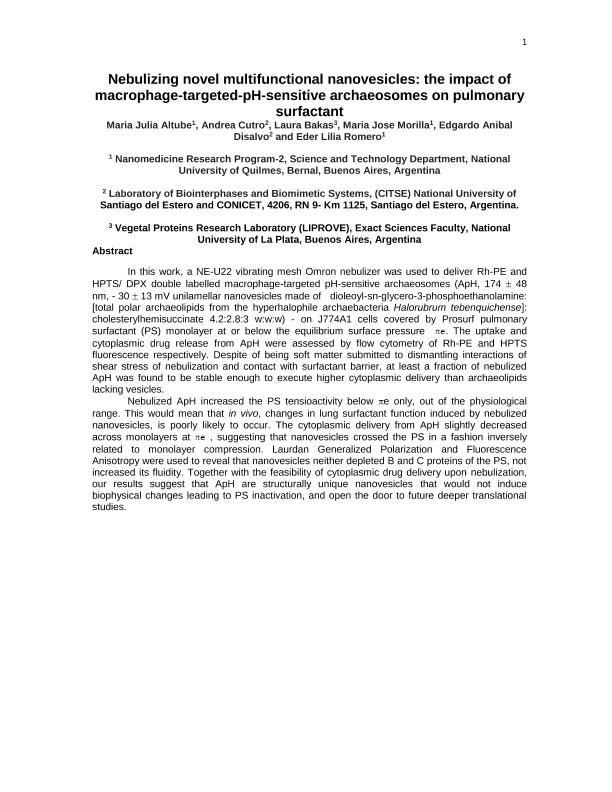Mostrar el registro sencillo del ítem
dc.contributor.author
Altube, María Julia

dc.contributor.author
Cutró, Andrea Carmen

dc.contributor.author
Bakas, Laura Susana

dc.contributor.author
Morilla, María José

dc.contributor.author
Disalvo, Edgardo Anibal

dc.contributor.author
Romero, Eder Lilia

dc.date.available
2019-05-02T19:16:14Z
dc.date.issued
2017-09
dc.identifier.citation
Altube, María Julia; Cutró, Andrea Carmen; Bakas, Laura Susana; Morilla, María José; Disalvo, Edgardo Anibal; et al.; Nebulizing novel multifunctional nanovesicles: The impact of macrophage-targeted-pH-sensitive archaeosomes on a pulmonary surfactant; Royal Society of Chemistry; Journal of Materials Chemistry B; 5; 40; 9-2017; 8083-8095
dc.identifier.issn
2050-750X
dc.identifier.uri
http://hdl.handle.net/11336/75446
dc.description.abstract
In this study, a NE-U22 vibrating mesh Omron nebulizer was used to deliver the Lissamine™ rhodamine B 1,2-dihexadecanoyl-sn-glycero-3-phosphoethanolamine triethylammonium salt (Rh-PE) and 8-hydroxypyrene-1,3,6-trisulfonic acid trisodium salt (HPTS)/p-xylene-bis-pyridinium bromide (DPX) double-labelled macrophage-targeted pH-sensitive archaeosomes (ApH, 174 ± 48 nm, -30 ± 13 mV unilamellar nanovesicles made of dioleoyl-sn-glycero-3-phosphoethanolamine: [total polar archaeolipids from the hyperhalophile archaebacteria Halorubrum tebenquichense]: cholesteryl hemisuccinate 4.2:2.8:3 w:w:w) to J774A.1 cells covered by a Prosurf pulmonary surfactant (PS) monolayer at or below the equilibrium surface pressure πe. The uptake and cytoplasmic drug release from ApH were assessed by flow cytometry of Rh-PE and HPTS fluorescence, respectively. Despite being soft matter, nanovesicles are submitted to the dismantling interactions of shear stress of nebulization and contact with the surfactant barrier, and at least a fraction of nebulized ApH was found to be stable enough to execute higher cytoplasmic delivery than archaeolipid-lacking vesicles. Nebulized ApH increased the PS tensioactivity to just below πe, which was beyond the physiological range; this finding indicated that changes in lung surfactant function induced by nebulized nanovesicles were less likely to occur in vivo. The cytoplasmic delivery from ApH slightly decreased across monolayers at πe; this suggested that nanovesicles crossed the PS in a fashion inversely related to monolayer compression. Laurdan generalized polarization and fluorescence anisotropy were used to reveal that nanovesicles neither depleted B and C proteins of the PS nor increased the fluidity of the PS. Together with the feasibility of the cytoplasmic drug delivery upon nebulization, our results suggest that ApH are structurally unique nanovesicles that would not induce biophysical changes leading to PS inactivation and open the door to deeper future translational studies.
dc.format
application/pdf
dc.language.iso
eng
dc.publisher
Royal Society of Chemistry
dc.rights
info:eu-repo/semantics/openAccess
dc.rights.uri
https://creativecommons.org/licenses/by-nc-sa/2.5/ar/
dc.subject
Nanomedicine
dc.subject
Surfactant
dc.subject
Macrophage
dc.subject.classification
Nano-materiales

dc.subject.classification
Nanotecnología

dc.subject.classification
INGENIERÍAS Y TECNOLOGÍAS

dc.title
Nebulizing novel multifunctional nanovesicles: The impact of macrophage-targeted-pH-sensitive archaeosomes on a pulmonary surfactant
dc.type
info:eu-repo/semantics/article
dc.type
info:ar-repo/semantics/artículo
dc.type
info:eu-repo/semantics/publishedVersion
dc.date.updated
2019-05-02T18:05:13Z
dc.journal.volume
5
dc.journal.number
40
dc.journal.pagination
8083-8095
dc.journal.pais
Reino Unido

dc.journal.ciudad
Londres
dc.description.fil
Fil: Altube, María Julia. Consejo Nacional de Investigaciones Científicas y Técnicas; Argentina. Universidad Nacional de Quilmes. Departamento de Ciencia y Tecnología. Laboratorio de Diseño de Estrategias de Targeting de Drogas; Argentina
dc.description.fil
Fil: Cutró, Andrea Carmen. Consejo Nacional de Investigaciones Científicas y Técnicas. Centro de Investigaciones y Transferencia de Santiago del Estero. Universidad Nacional de Santiago del Estero. Centro de Investigaciones y Transferencia de Santiago del Estero; Argentina
dc.description.fil
Fil: Bakas, Laura Susana. Universidad Nacional de La Plata. Facultad de Ciencias Exactas; Argentina
dc.description.fil
Fil: Morilla, María José. Consejo Nacional de Investigaciones Científicas y Técnicas; Argentina. Universidad Nacional de Quilmes. Departamento de Ciencia y Tecnología. Laboratorio de Diseño de Estrategias de Targeting de Drogas; Argentina
dc.description.fil
Fil: Disalvo, Edgardo Anibal. Consejo Nacional de Investigaciones Científicas y Técnicas. Centro de Investigaciones y Transferencia de Santiago del Estero. Universidad Nacional de Santiago del Estero. Centro de Investigaciones y Transferencia de Santiago del Estero; Argentina
dc.description.fil
Fil: Romero, Eder Lilia. Consejo Nacional de Investigaciones Científicas y Técnicas; Argentina. Universidad Nacional de Quilmes. Departamento de Ciencia y Tecnología. Laboratorio de Diseño de Estrategias de Targeting de Drogas; Argentina
dc.journal.title
Journal of Materials Chemistry B
dc.relation.alternativeid
info:eu-repo/semantics/altIdentifier/doi/http://dx.doi.org/10.1039/C7TB01694H
dc.relation.alternativeid
info:eu-repo/semantics/altIdentifier/url/https://pubs.rsc.org/en/content/articlelanding/2017/TB/C7TB01694H
Archivos asociados
